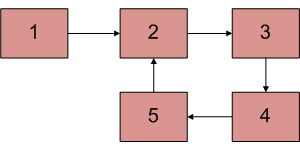Dada una lista enlazada con un bucle, la tarea es encontrar si es palíndromo o no. No se le permite eliminar el bucle.

Ejemplos:
Input: 1 -> 2 -> 3 -> 2
/| |/
------- 1
Output: Palindrome
Linked list is 1 2 3 2 1 which is a
palindrome.
Input: 1 -> 2 -> 3 -> 4
/| |/
------- 1
Output: Not Palindrome
Linked list is 1 2 3 4 1 which is a
not palindrome.
Algoritmo:
- Detecte el bucle utilizando el algoritmo de detección del ciclo de Floyd.
- Luego encuentre el Node de inicio del ciclo como se explica en este .
- Verifique que la lista vinculada sea palíndromo o no, como se explica en este .
A continuación se muestra la implementación.
Javascript
<script>
// Javascript program to check if a
// linked list with loop is palindrome
// or not.
class GfG{
// Link list node
class Node
{
constructor()
{
this.data = 0;
this.next = null;
}
}
/* Function to find loop starting node.
loop_node --> Pointer to one of the loop
nodes head --> Pointer to the start node
of the linked list */
function getLoopstart(loop_node, head)
{
var ptr1 = loop_node;
var ptr2 = loop_node;
// Count the number of nodes in
// loop
var k = 1, i;
while (ptr1.next != ptr2)
{
ptr1 = ptr1.next;
k++;
}
// Fix one pointer to head
ptr1 = head;
// And the other pointer to k
// nodes after head
ptr2 = head;
for (i = 0; i < k; i++)
ptr2 = ptr2.next;
/* Move both pointers at the same pace,
they will meet at loop starting node */
while (ptr2 != ptr1)
{
ptr1 = ptr1.next;
ptr2 = ptr2.next;
}
return ptr1;
}
/* This function detects and find loop
starting node in the list */
function detectAndgetLoopstarting(head)
{
var slow_p = head, fast_p = head,
loop_start = null;
// Start traversing list and detect loop
while (slow_p != null && fast_p != null &&
fast_p.next != null)
{
slow_p = slow_p.next;
fast_p = fast_p.next.next;
/* If slow_p and fast_p meet then find
the loop starting node */
if (slow_p == fast_p)
{
loop_start = getLoopstart(slow_p, head);
break;
}
}
// Return starting node of loop
return loop_start;
}
// Utility function to check if a linked
// list with loop is palindrome with given
// starting point.
function isPalindromeUtil(head, loop_start)
{
var ptr = head;
var s = [];
// Traverse linked list until last node
// is equal to loop_start and store the
// elements till start in a stack
var count = 0;
while (ptr != loop_start ||
count != 1)
{
s.push(ptr.data);
if (ptr == loop_start)
count = 1;
ptr = ptr.next;
}
ptr = head;
count = 0;
// Traverse linked list until last
// node is equal to loop_start second
// time
while (ptr != loop_start ||
count != 1)
{
// Compare data of node with
// the top of stack
// If equal then continue
var stk = s.pop();
if (ptr.data == stk);
// Else return false
else
{
s.push(stk);
return false;
}
if (ptr == loop_start)
count = 1;
ptr = ptr.next;
}
// Return true if linked list is
// palindrome
return true;
}
// Function to find if linked list
// is palindrome or not
function isPalindrome(head)
{
// Find the loop starting node
var loop_start =
detectAndgetLoopstarting(head);
// Check if linked list is palindrome
return isPalindromeUtil(head,
loop_start);
}
function newNode(key)
{
var temp = new Node();
temp.data = key;
temp.next = null;
return temp;
}
// Driver code
var head = newNode(50);
head.next = newNode(20);
head.next.next = newNode(15);
head.next.next.next = newNode(20);
head.next.next.next.next =
newNode(50);
// Create a loop for testing
head.next.next.next.next.next =
head.next.next;
if (isPalindrome(head) == true)
document.write("Palindrome");
else
document.write("Not Palindrome");
// This code is contributed by aashish1995
</script>
Producción:
Palindrome
Complejidad de tiempo : O (n) donde n no es ningún Node en la lista enlazada
Espacio auxiliar : O(n) donde n es el tamaño de la Lista
¡ Consulte el artículo completo sobre Verifique que la lista vinculada con un bucle sea palíndromo o no para obtener más detalles!
Publicación traducida automáticamente
Artículo escrito por GeeksforGeeks-1 y traducido por Barcelona Geeks. The original can be accessed here. Licence: CCBY-SA